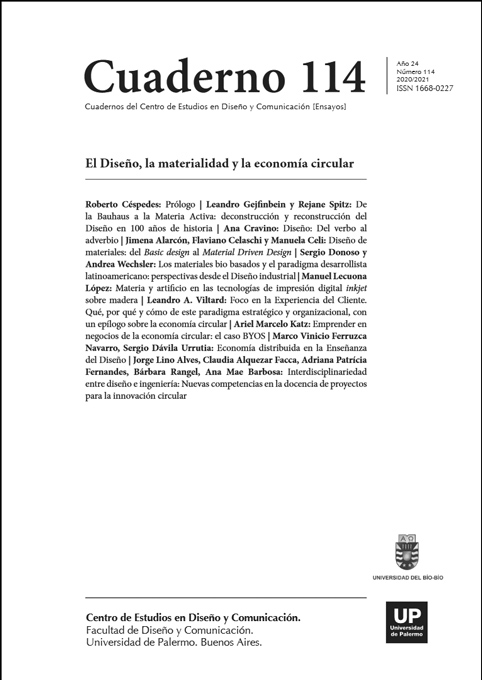Materia y artificio en las tecnologías de impresión digital inkjet sobre madera
Abstract
This text aims to demonstrate how Digital Printing Inkjet technologies are enabling the visual characteristics of surfaces of a different nature to rekindle the discussion between nature and artifice, because the artificial object is leaving transforming into nature as the basis of technological civilization. It seeks to distance himself from the treatment of matter as a result of the complex creative act that achieves something unique and unique. It aims to observe the creative work supported by Digital Printing Inkjet technologies, on human artifacts, objects and habitats. For this reason, it is available as an exploratory observation to obtain a judgement on the problem and as an introductory part of a descriptive study. This text is considered an exploratory research, because it seeks to know the relationship between matter and artifice, focused from the potential of Digital Printing Inkjet technology.
References
Augé, M. (2004). Los no lugares. Espacios del anonimato. Barcelona: gedisa.
Baudrillard, J. (2006). El complot del arte. Buenos Aires: AMORRORTU.
Carboni, M. (2005). Abet Laminati e Ettore Sottass. 40 anni di lavoro insiene. Milán: Trienale de Milano.
Colin, C. (1994). Editorial. En C. Colin, Autentik (pág. 141). Liège: Pierre Mardaga.
Costoya, M. (2011). Arquitectura Procesual: Naturaleza y artificio. Madrid: VEAD. Veredes arquitectura y divulgación.
Derrida, J. S. (1998). Ecografías de la televisión. Buenos Aires: Eudeba.
Diez Medina, C. (2010). Materia y Artificio. En AA.VV, La materia de la arquitectura = The matter of architecture (pág. 8). Ciudad Real, Ciudad Real, España: Fundación Miguel Fisac. Recuperado el 21 de septiembre de 2019, de http://oa.upm.es/49442/
Dorfles, G. (1972). Naturaleza y artificio (2 ed., Vol. 1). Barcelona, Cataluña, España: Lumen. Recuperado el 12 de 9 de 2019
Eek, P. H. (1 de Noviembre de 2019). PIET HEIN EEK. Obtenido de https://pietheineek.nl/ Ettore Sottsass, B. R. (1999). Ettore Sottsas. Milan : Cosmit.
Gric, .. (16 de abril de 2019). Haciendo las cosas simples aun más simples. MAGAZIN Products, 31. (T. Edelmann, Entrevistador, & Stylepark, Editor) Stylepark. Recuperado el 2 de septiembre de 2019, de https://www.stylepark.com/en/news/plank-konstantin-grcicfila-cup-myto-miura?utm_source=www.stylepark.com%2Fen&utm_medium=newslett
Hesse, S. H. (2017). Full House: Design by Stefan Diez. Cologne: Cologne Museum of Industry and Crafts.
Kester, P. V. (1985). Fron Bauhaus to Blokker Michele De Lucchi: Dialogue with banal. En Michele De Lucchi (pág. 62). Tilburg: Idea Books.
Lier, H. V. (1974). Objeto y estética. En M. B. Abrahan, Los objetos (pág. 205). Buenos Aires: Tiempo Contemporáneo SA.
Loetitia Corneille, E. L. (1999). Interview Chantal Hamaide: Recontre, Charlotte Perriand et six femmes designers européennes. (IRD, Ed.) AZIMUTS, 96. Obtenido de https:// revue-azimuts.fr/archives/AZ16
Lucchi, M. D., Koster, G., & Radice, B. (1999). Ettor Sottsass. Milano: Cosmit.
Manzini, E. (1992). Artefactos. Acia una ecología del ambiente artificial. Madrid: Celeste / Experimenta Ediciones de Diseño. Margaritelli. (2018). Natural Genius. Perigia: Margaritelli S.p.a. Obtenido de file:///F:/030- EMP_Industriales/Valresa/NOTICIAS/2018/Ref_12_07_2018-X_Suelo_madera/Listone%20Giordano/MLG-18-Catalogo_NG_26giugno2018_affiancate.pdf
Martínez, M. (septiembre de 2014). Humano en exceso: el artificio de la naturalea y su encrucijada técnica. (C. M. (CMD), Ed.) IF: Diseño y naturaleza, 1(9). Recuperado el 3 de septiembre de 2019, de https://maestriadicom.org/articulos/humano-demasiado-humano/
Mayer, P. (1994). Préface. En C. Colin, Autentik (pág. 141). Liège: Pierre Mardaga.
Moles, A. A. (1974). Teprís de los objetos (1 ed.). Barcelona, Cataluña, España: Gustavo Gili. Colección comunicación visual.
Pasca, V. (1991). Vico Magistertti diseñador. Barcelona: Gustavo Gili S.A.
Perriand, C. (1995). Avant-propos. En VVAA, Autentik (pág. 141). Liège: Pierre Mardaga.
Radice, B. (1984). MENPHIS. Milano: Gruppo Editoriale Electa.
S. Tasma-Anagyros, F. L. (1998). Et si on remettait les computers à zéro. Hypothèses pour des futurs probables. Besançon: Les éditions de l'imprimeur.
Schmidt, P. (16 de Abril de 2008). MYTO a cantilever chair. Ludwigshafen am Rhein, Renania, Alemania: Meiré und Meiré.
Torio, J. L. (2011). Gayascas. Historia, naturaleza y artificio. (U. C. Madrid, Ed.) Escritura e Imagn(Vol.7 (2011)), 8. doi:https://doi.org/10.5209/rev_ESIM.2011.v7.37779
Villacorta, J. (13 de 7 de 2009). El Norte de Castilla 165. Obtenido de https://www.elnortedecastilla.es/20090713/articulos_opinion/naturaleza-artificio-20090713.html
Warnier, J. P. (1994). Authentique? Facettes, détours, pièges et paradoxes. En C. Colin, Autentik (pág. 141). Liège: Pierre Mardaga.
Los autores/as que publiquen en esta revista ceden los derechos de autor y de publicación a "Cuadernos del Centro de Estudios de Diseño y Comunicación", Aceptando el registro de su trabajo bajo una licencia de atribución de Creative Commons, que permite a terceros utilizar lo publicado siempre que de el crédito pertinente a los autores y a esta revista.


